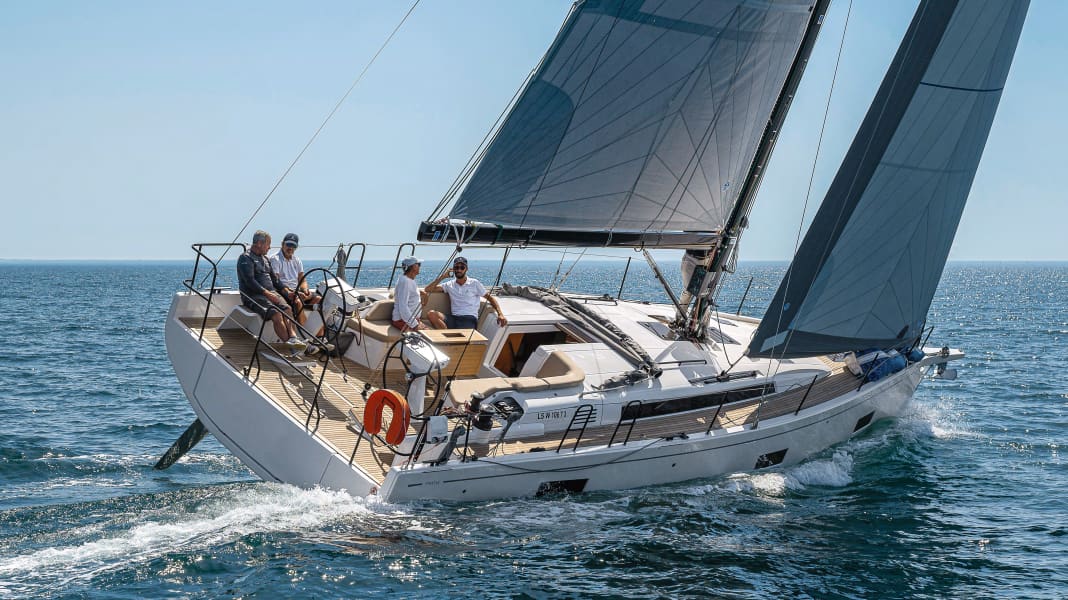
A good compromise between sportiness and performance on the one hand and comfort and cosiness on the other - that is what characterises modern performance cruisers. Of course, it is not easy to find this golden mean. This was recently demonstrated by the large YACHT comparison in the 38-foot class impressive.
This extremely exciting group test included the First 36 from Beneteau, the not-so-little sister of the new First 44. Built in Slovenia by Seascape, the eleven-metre yacht from the French market leader is more of a performer than a cruiser. Both its concept and construction emphasise the sporty aspect. Good sailing performance and regatta suitability are more in focus than cosiness and comfort. This does not mean that the First 36 is not ideal for extended holiday cruises. However, its makers took a more consistent approach to eliminating unnecessary features and reducing weight, which is an art in series production.
One boat, two versions
The First 44 takes a different approach, and deliberately so. Compared to the 36, its basic concept is more balanced and therefore more versatile - on the one hand because expectations of the quality of life below deck generally increase with increasing boat size, and on the other hand because Beneteau offers the model in two versions. The basic version is designed for fast cruising. It has a cockpit layout designed for small crews. This means that sheets, halyards and outhauls are routed laterally below deck and inside the cockpit coaming on two winches in front of the helm stations, where they can also be easily reached by the helmsman.
In the First 44 Performance version, on the other hand, the boat has a cockpit that meets the needs of an active regatta crew, while the deck remains the same. Primary and secondary winches are then available on the coamings for the mainsail and genoa sheets. The halyards and trim lines, on the other hand, are operated on the coachroof on both sides of the companionway. The boat also has a carbon fibre mast that is 1.60 metres higher than the standard aluminium rig, a deeper but lighter and more efficient T-keel and a carbon fibre bowsprit that has been significantly extended to 1.50 metres. A traveller is also bolted to the cockpit floor, and the deck equipment is better and of higher quality overall.
All these measures result in a weight saving of 550 kilograms. And those who wish can also equip the First 44 Performance with side-mounted water ballast tanks with a capacity of 350 litres each, for example for long-distance races with a reduced crew. There has never been so much "tuning" ex works in large-scale production before.
Beneteau is thus following in the footsteps of smaller brands focussed on the performance sector. Cantiere del Pardo, for example, has presented a similar spread in its range with the Grand Soleil 44 Performance (test YACHT 2/2021), which can therefore be considered a direct competitor to the First 44. Italia Yachts will also soon be presenting a convertible concept for the new Italia 12.98, which is due to make its debut soon.
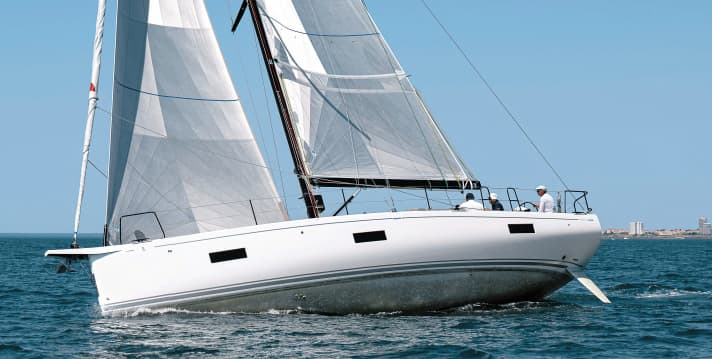
No other brand offers such a wide range
The First is therefore in good company. And it is also a strategically important model for Beneteau, as it closes the previously large gap in the programme between the sporty 36 and the upmarket First 53 ( here in the YACHT test ). The French thus cover practically the entire market - from the purist First 14 gennaker dinghy to the established flagship. No other brand offers such a wide range.
While the designs of the smaller boats up to the First 36 all come from the office of Sam Manuard, who has made a name for himself in Class 40 and recently also with the Imocas, Beneteau is relying on the skills of Roberto Biscontini from Italy, a sought-after architect in Cup circles, for the larger yachts. His compatriot Lorenzo Argento is responsible for the styling on and below deck.
This co-operation resulted in visually attractive and innovative designs. The wide stern with the flat frame and the soft chines, which define an edge in the freeboard that is pulled far up aft, have a striking effect. This allows Biscontini to constrict the waterline and reduce the wetted surface - good in light winds. Double rudder blades are essential to ensure that the construction works perfectly downwind, even when there is more pressure.
Beneteau will officially present the First 44 to the general public for the first time at the Yachting Festival in Cannes in September. The shipyard gave YACHT and our colleagues from "Voiles et Voiliers" a test run off Les Sables-d'Olonne long beforehand.
The Beneteau First 44 in detail:
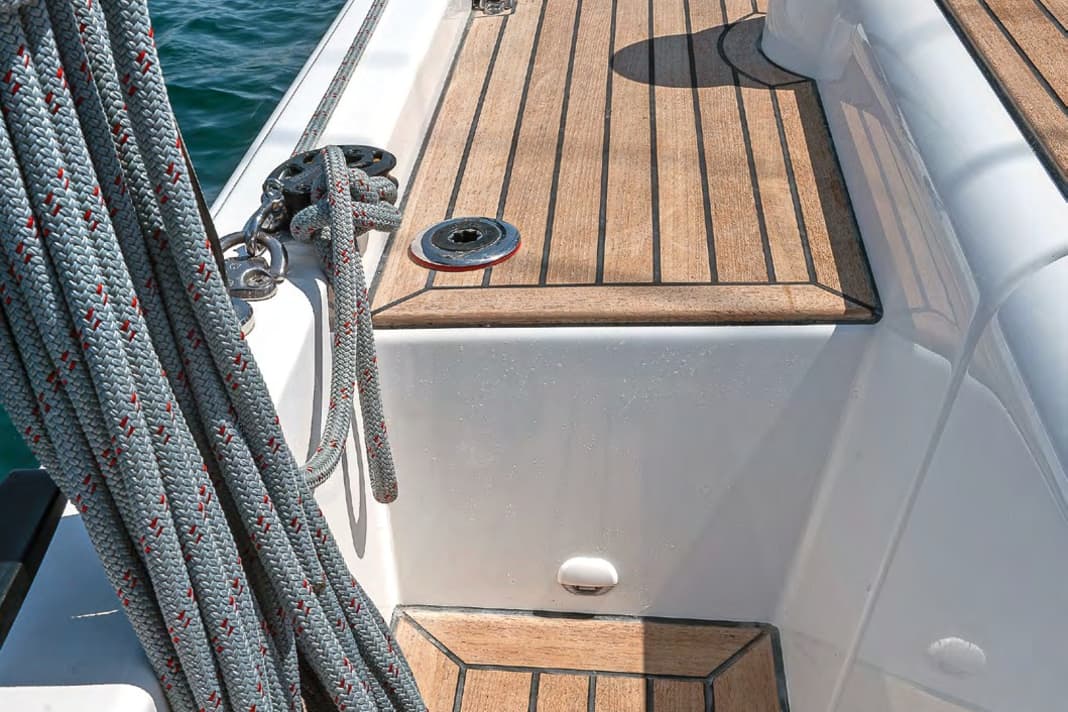





Beneteau First 44 in the first sail test
The prototype was available to us there in the standard version, i.e. with the simpler, cruising-oriented deck layout without a traveller. However, the boat was fitted with the more powerful performance rig, which is otherwise used on the regatta version with the significantly deeper T-keel (2.60 metres instead of 2.15 metres). This means a total of eleven square metres more sail area, which proved to be a real plus for the test in the Bay of Biscay.
In a nice sea breeze of ten to twelve knots, the First 44 performed strongly upwind. Without having to pinch, the boat runs through the water at a height of 40 degrees to the true wind direction at a speed of just under seven knots. At first glance and also in comparison, these are remarkably good performance data for a performance cruiser of this size and in the given conditions.
With Code Zero and a wind angle of around 100 degrees, the boat averages 9.2 knots; occasionally it scratches the ten-knot mark. The competition will therefore have to work hard to keep up with the speed of the First 44.
The two First 44 options in detail
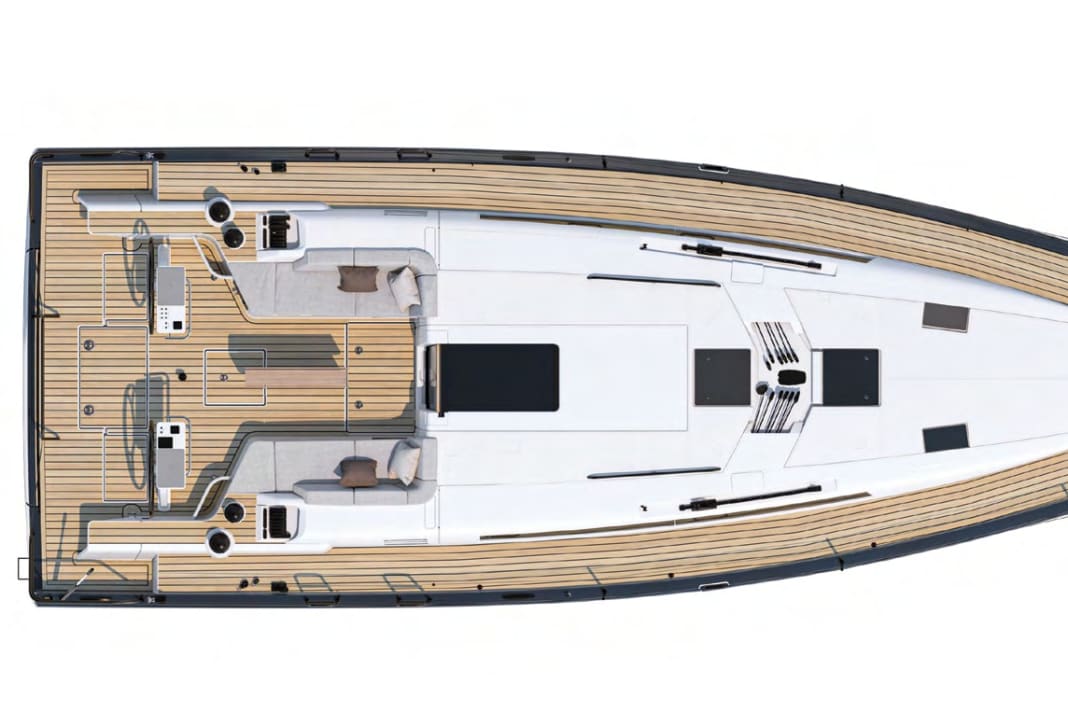


Expansion without wow effects, but with function
However, it is noticeable in the test that the Frenchwoman is travelling hard upwind with quite a lot of heel. She sails with an angle of between 25 and 27 degrees, which feels like being in a steep wall due to the large width in the cockpit. If the helmsman can still compensate for this with fold-out footrests, the crew have to wedge themselves against the cockpit table upwind.
The extent to which this peculiarity can be attributed to the higher mast on the test boat in combination with the standard keel remains difficult to categorise due to a lack of direct comparability. In any case, it is clear that the significantly larger and more powerful sail plan actually requires a traveller in order to be able to trim the high and narrow pinhead mainsail efficiently. However, this is reserved for the performance version; it is not even available as an option for the basic version of the First 44.
The cockpit layout is comparable to that of the larger First 53. However, there are two versions
Nevertheless, despite a relatively high heel, the First runs cleanly on course, parries the gusts well and sits perfectly on the rudder. The boat responds immediately to small corrections to the wheels, which makes it easy to stay on the wind edge at all times and utilise its full performance potential. The two large winches mounted in front of the steering columns also allow the helmsman to operate the sheets for the mainsail and genoa as well as halyards and outhauls himself. This is even easier if you sit in front of the steering column, where the wheel, winches and stoppers are all within easy reach. The First 44 therefore offers a high degree of one-handed manoeuvrability.
Short distances, compact layout
There is also enough space for the co-sailors to work on the sheets between the cockpit thwarts and the steering wheels. However, the two winches are very close together and also close to the stoppers, where no fewer than eight lines arrive on either side. The distances are therefore very short, which requires concentration and caution, especially when all winches are electrically operated as on the test boat. In addition, the crowded arrangement has the side effect that the many loose ends quickly form a churn. The side-mounted halyard pockets only help to a limited extent because they are too small and therefore only provide limited organisation.
As a unique selling point within the performance cruiser class of this size, both versions of the First 44 offer a dinghy garage in the stern, in which a 2.40 metre long inflatable boat can be stowed transversely. The aft peak is completely sealed off from the rest of the boat.
The shipyard has installed generous inspection and maintenance hatches for the components of the steering mechanism concealed behind it. With two rudder blades, good accessibility is important in order to be able to readjust the angle of attack if necessary. However, should major problems arise in the steering mechanism or components need to be replaced, the inner shell of the dinghy garage will have to be at least partially opened.
What the Beneteau First 44 offers below deck
Below deck, the First 44 has a standard cabin layout with two double cabins aft, a spacious owner's area forward and two heads compartments. There are no plans for alternative layouts. If you want to use the boat for touring and have a lot of equipment with you, you can use one of the aft cabins as a large, walk-in storage space, which can also be accessed from the cockpit.
In one respect, however, designer Lorenzo Argento went his own way, similar to the First 53: the First 44 has a dinette. It offers two benches arranged at right angles to the direction of travel with a central table instead of the longitudinal sofa in a U or L shape. This outdated arrangement also makes sense because the mast support is positioned very far aft, in the centre of the saloon. The usual arrangement with two long rows of sofas and a large table could therefore only have been realised with drastic compromises. Converted into a berth, the dinette can also be used as an additional double bed with a length of 2.00 metres and a width of 1.32 metres. The table can be lowered for this purpose.
Sober functionality characterises the interior below deck. But it's still not uncomfortable inside
A largely free-standing island bed is installed in the foredeck. Because the berth extends far into the bow, the space for sleeping at the shoulders is limited, at least with double occupancy. In the aft cabins, on the other hand, the berths are wider (1.40 metres at shoulder height) and almost rectangular. Two people can sleep comfortably here.
However, there is one drawback: there are no handrails. At sea, you will search in vain for a secure hold below deck. There are raised edge handrails for navigation and galley as well as the mast support to hold on to. However, there are no corresponding handles at waist height or on the ceiling for the passage forwards.
In another respect, however, the boat shows practicality: In addition to many hatches in all living areas, which also allow cross ventilation, Beneteau now installs dorade vents in the cabin roof as standard. This has not been available for some time - great!
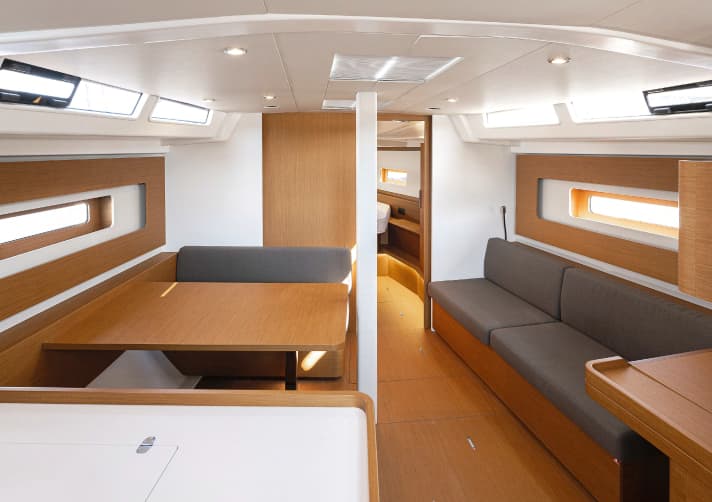
Expert teams for every type at Beneteau
The hull and deck of the First 44 are manufactured as a GRP sandwich construction using the vacuum infusion process. The shipyard uses balsa wood as the core material for the hull and foam panels for the deck. Incidentally, the First 44 is being built exclusively in a completely new production facility set up especially for this type with a dedicated core team.
Beneteau is thus testing a form of organisation and work that is to be adopted for all models of all brands in future: independent production facilities or production islands. The same employees will then always work on the same boat types. In this way, the shipyard aims to guarantee a faster start to series production while at the same time ensuring higher quality. A promising approach.
In the case of the First 44, this approach already seems to be paying off. Although the interior is visually very sober and functional, it is well finished in detail: Cleanly installed on-board technology and precisely laid floorboards, which do not creak even under load, are proof of this. In general, it remains very quiet below deck even when sailing, which speaks not least in favour of good construction and finishing quality.
A final calculation is not yet possible. However, the base price seems attractive in comparison
The early and exclusive test date unfortunately comes with an information gap. Although the shipyard has set the basic price, extras and option packages have not yet been finalised. As a result, we are unable to provide the usual YACHT calculations for the time being, but we will provide these details as soon as possible. The basic version of the boat costs 398,650 euros - quite favourable compared to the competition. The performance version costs 50,000 euros more and is also fairly priced.
The First 44 presents itself as a strong piece of yacht building. The modern design, beautiful lines and sailing characteristics are impressive, as are the price and versatility.
Technical data Beneteau First 44
- Designer: Biscontini/Argento
- CE design category: A
- Torso length: 13,17 m
- Total length: 14,15 m
- Waterline length: 12,82 m
- Width: 4,25 m
- Draught/alternative: 2,15/2,60 m
- Mast height above waterline: 20,57 m
- Theoretical torso speed:8.7 kn
- Weight: 10,5 t
- Ballast/proportion (hours): 3,3 t/31 %
- Mainsail (Classic):53,0 m2
- Furling genoa (106 %): 53,0 m2
- machine (Yanmar): 42 kW/57 hp
- Fuel tank:200 l
- Fresh water tanks: 200 + 170 l
- Holding tanks:2x 67 litres
Sailing performance
without drift/current; wind speed: 10 kn (3 Bft), wave height: smooth water
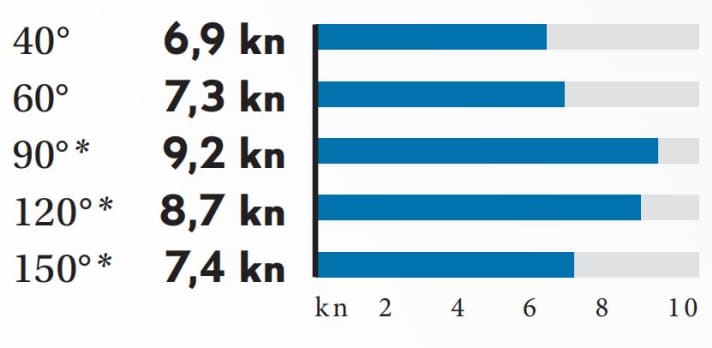
(* with code zero)
Potential STZ1 = 4.7

The First 44 is no lightweight. Nevertheless, the sail carrying capacity is in the sporty range
(Dimensionless number. Calculation: 2 √S/3 √V. The higher the value, the more sail area (S) the ship has in relation to the displacement (V))
Hull and deck construction
GRP sandwich construction with balsa wood core (hull) and foam core (deck), built using the vacuum infusion process. Structural floor assembly with furniture foundations glued into the hull.
Rig and sail
Standard aluminium mast (Sparcraft) with two spreaders and Dyform shrouds. Split backstay with hydraulic tensioner. Optional carbon rig (+ 1.60 metre mast height) with rod shrouds. The sails are not included in the basic price.
Engine & Gearbox
Yanmar 4JH57 with Saildrive propulsion and three-blade folding propeller. No alternative to the standard engine is planned. However, the engine's performance is perfectly adequate for the ship.
Equipment and prices
- Base price ex shipyard:398.650 €
- Price ready to sail: Prices still missing
- Comfort price: Prices still missing
- Guarantee/against osmosis: 2/2 years
Shipyard
Chantier Beneteau, 85850 Saint Gilles-Croix-de-Vie (France), www.beneteau.com
Distribution
Dealer network
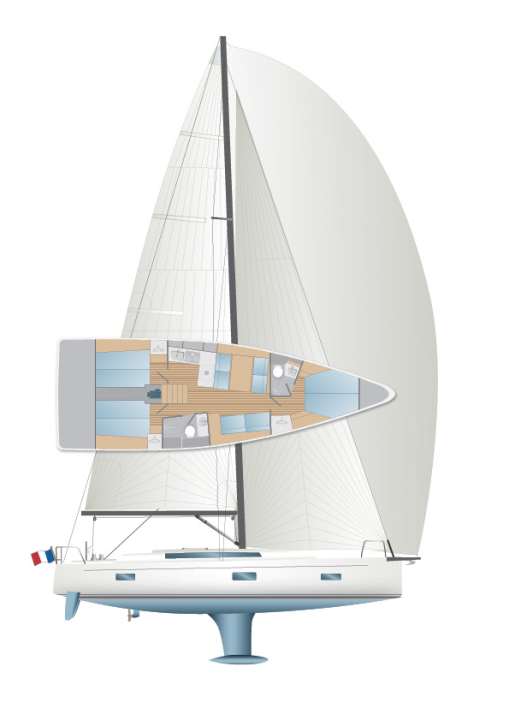
Yacht Rating Beneteau First 44
A harmonious mix of sporty sailing characteristics and touring suitability. The concept impresses with its high degree of versatility. Favourable basic price for basic and regatta version
Design and concept
+ Modern, high-performance tear
+ Choice of two variants
- Robust construction
Sailing performance and trim
+ High speed potential, good height
+ Good handling for small crew
- Relatively high heeling on the wind
Living and finishing quality
+ No-frills functionality
+ Dinette as a special feature
- Narrow double bed in the foredeck
Equipment and technology
+ Enclosed dinghy garage
+ Water ballast tanks possible
- Traveller not standard
Chic, fast and exclusive: the new Beneteau First 44 meets this competition
Arcona 435
Beautiful and comparatively slim ship from Sweden with very good sailing characteristics in the test. Interior design with a choice of two or three double cabins and two toilet rooms.Hull length 13.20 m; width 4.04 m; weight 8.9 tonnes; from 557,960 euros
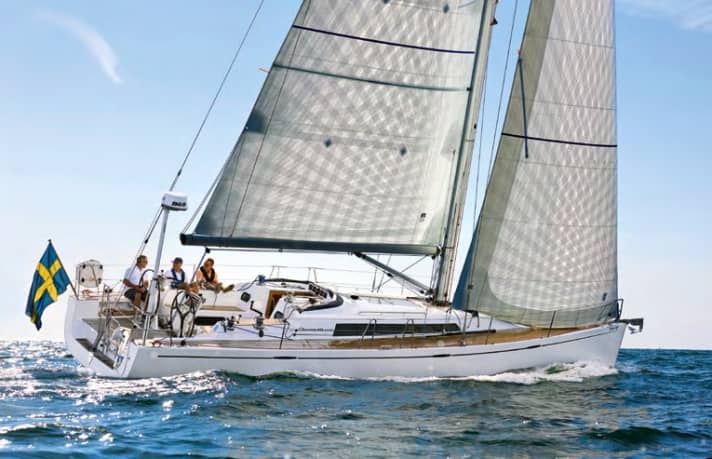
Grand Soleil 44 Performance
Attractive performance cruiser from Italy with plenty of performance potential. Similar to the First 44, the boat is available in two versions as a sports tourer or as a racer with more sail area.Hull length 13.40 m; width 4.30 m; weight 9.5 tonnes; from 403,410 euros

Italia 12.98
It will be presented as a new release at the trade fair in Cannes in September. The Cossutti design is also available as a sporty tourer or as an optimised regatta boat.Hull length 13.16 m; width 3.95 m; weight 8.5 tonnes; from 408,200 euros

XP 44 MK II
Powerful and successful boat (IRC/ORC) from the regatta orientated XP series from X-Yachts. Built using the vacuum infusion process with epoxy resin; hull reinforcements made of carbon.Hull length 13.29 m; width 4.07 m; weight 8.6 tonnes; from 467,435 euros

